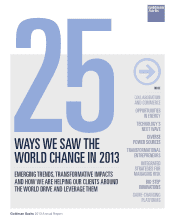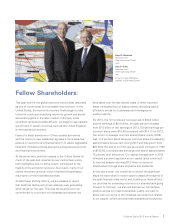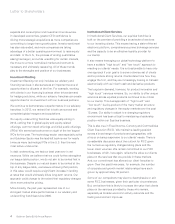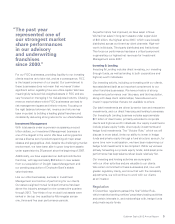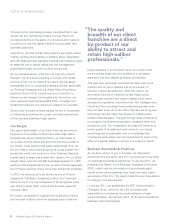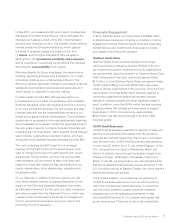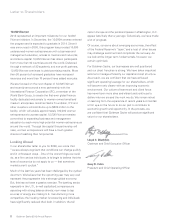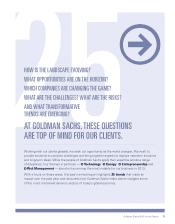Goldman Sachs 2013 Annual Report Download - page 5
Download and view the complete annual report
Please find page 5 of the 2013 Goldman Sachs annual report below. You can navigate through the pages in the report by either clicking on the pages listed below, or by using the keyword search tool below to find specific information within the annual report.3Goldman Sachs 2013 Annual Report
the challenges presented in the current environment. At the
same time, we want to protect our ability to provide significant
upside to shareholders as the economic cycle turns.
By focusing on revenues, expenses and capital efficiency,
we are building near-term benefits, but also driving material
operating leverage into our business.
Our performance over the last few years is an important
example of the firm’s ability to proactively manage a cyclical
business and to capitalize on creating operating leverage
in our business model. In 2011, we announced an initial
$1.2 billion expense savings initiative, the size of which was
subsequently increased twice, ultimately reaching a run-rate
of $1.9 billion. In 2012, a 19 percent increase in net revenues
translated into an 82 percent increase in pre-tax earnings and
a ROE expansion to 10.7 percent. In 2013, despite essentially
unchanged net revenues, our continued focus on expenses
enabled us to grow pre-tax earnings by five percent and
expand ROE to 11.0 percent. Longer term, we expect that
a more robust environment will enable us to deliver even
more operating leverage to our shareholders.
With respect to capital management, our strong capital
generation and balance sheet management have allowed us to
grow our Basel III ratio while returning capital to shareholders.
Since year-end 2010, we have repurchased approximately
$17 billion of our shares, and reduced our basic share count
by approximately 80 million shares or 15 percent, while our
U.S. peers, taken together, actually showed an average
increase in share count. Our approach drives shareholder
value through both higher returns and growth in earnings
per common share.
Controlling Costs
In addition to effective capital management, we are acutely
focused on expense management as a lever for driving
incremental shareholder returns. From 2009 through 2013,
our average compensation and benefits expense to net
revenues ratio was approximately 880 basis points lower
than the average ratio from 2000 to 2007.
Compensation and benefits is our largest expense and we
remain committed to paying for performance. In lower net
revenue years, like 2008 and 2011, we demonstrated
significant flexibility in our compensation and benefits
expense. In years with net revenue growth, this expense
generally increased at a lower rate than net revenues, thereby
driving operating leverage and enhancing shareholder returns.
The firm remains committed to operating efficiently for
our shareholders, while providing world-class service to our
clients. Of course, maintaining discipline around costs
requires making tough decisions regarding staffing levels
and compensation. We have strived to get the balance right,
between improving shareholder returns and investing in the
future of our client franchise. To do so, we have leveraged
technology, adjusted our allocation of resources and managed
both compensation and non-compensation expenses.
Our expense savings initiatives included enhancements in
technology and greater geographic diversity in our workforce.
Currently, we have approximately 8,200 staff, or roughly
25 percent of our workforce, located in Bangalore, Salt Lake
City, Dallas and Singapore, compared with 10 percent in
2007. Additionally, 38 percent of all campus and experienced
hires since 2011 have been hired into those offices.
We were among the first global banks to embark on
an expense savings initiative and, although painful, the
exercise was necessary. Being an early mover allowed
ongoing recognition of savings over the past two years and
protected returns in what continues to be a challenging
operating environment.
Growth and the State of Our Client Franchise
While we have strengthened our balance sheet, prioritized
efficient capital allocation and taken a disciplined approach
to costs, we have continued to invest in a broad set of
institutionally focused businesses that have a track record
of providing higher returns than many other businesses within
financial services. Because of a consistent focus on our
clients’ needs and orienting our businesses to meet their
ongoing objectives, we believe we have provided solid
returns in a challenging period, while seeking to protect our
ability to provide significant upside to our shareholders as
the economic cycle turns.
We believe our businesses are particularly well positioned
for the time when broad-based growth resumes. And, we
see reasons to be confident in the fundamentals of the global
economy. While emerging markets typically entail higher risk
and volatility, we believe that over time they will generate
stronger growth as the middle class in those countries

